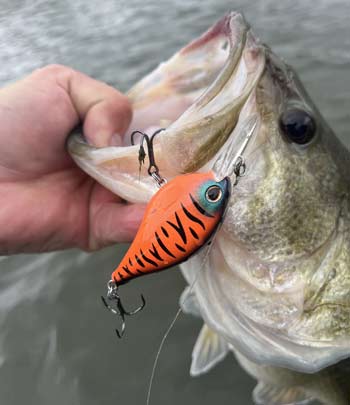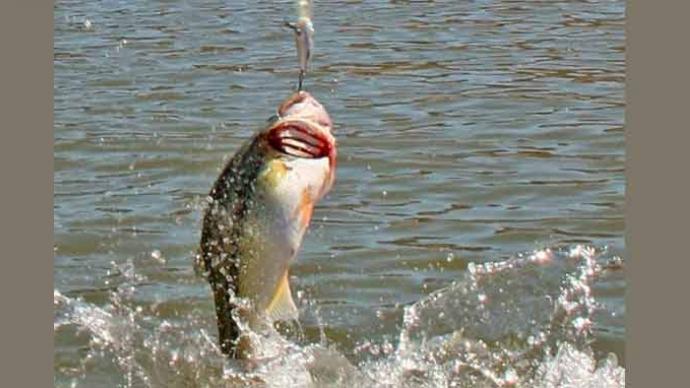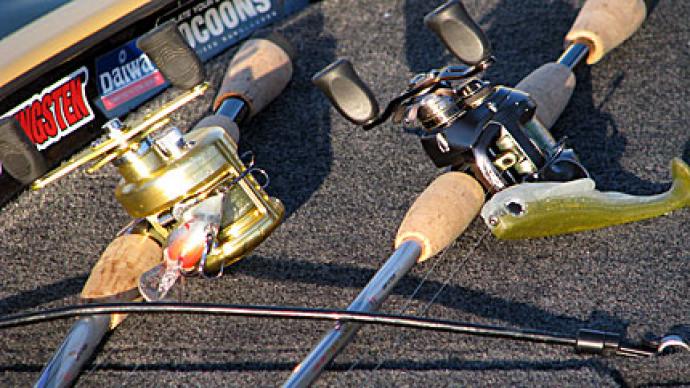
One of the best ways to catch a bass is to use a lure that looks like what they are eating, making a crankbait such an effective lure. These timeless baits have been used for decades and continue to catch fish every year because of how well they work. They come in all sizes and feature a bill that allows the bait to dive to just about any depth you want.
In this article, we'll discuss the three primary types of diving crankbaits and share some insight on how and where to fish them.
Shallow Crankbaits – 5 feet and less
One of the best ways to fish around shallow cover is with a crankbait with a square bill or a shallow lip that keeps the bait from diving too deep. Even though these baits have two sets of treble hooks, you can fish them right around logs, rocks, and laydowns without hanging up as much as you might think.
When fishing around shallow objects, the key is to let the bill do the work and deflect off of cover. Another key is speed, and often, the slower you reel the bait, the more likely your treble hooks will snag something. A fast retrieve speed is also helpful in getting the bass to react, and often, they will bite the bait, zooming past them out of reaction instead of thinking it looks like a meal.
Shallow cover is a great place to start with baits like this, and you can add docks, seawalls, boulders, and other objects as good places to throw them. Some of the best baits to use in this category are square bills like the Strike King KVD 1.5 and Berkley Squarebull and balsa baits like the PH Customs Lil Hunter.
Mid-Range Cranking – 5 to 15 feet of water

This is a sweet spot for most crankbaits as it is a zone where many bass live for much of the year. There are many options here, including deeper-diving squarebills and standard diving crankbaits.
When fishing mid-range and using a crankbait, it's a good idea to use a bait that dives slightly deeper than the water you are fishing in. The bait can dig into the bottom, cause a commotion, and get the fish to react. A standard retrieve will work for both baits, but you can experiment with faster and slower retrieves based on how cold the water is while maintaining bottom contact at least a few times during each retrieve.
One key with these baits is to choose a bait that looks like what they are eating. You can either use a shad imitator or something that looks like a crawfish. An excellent overall bait is a flat-sided bait like the Rapala DT Series or Berkley Dime. Both come in several diving depths and a host of different colors. A few great options for imitating crawfish are the Storm Wiggle Wart, SPRO RKCrawler, and the 6th Sense Curve 55, each with a crawfish profile and excellent wobbling action.
Deep Divers – 15 feet and deeper
The final category is baits that will dive to the depths, reaching over 15 feet of water and as deep as 30 feet. These baits shine in the months when bass are at their deepest, generally in the middle of summer and winter.

Like the mid-range crankbaits, it pays to use a bait that dives slightly deeper than the water you are fishing. Choose a bait that will reach 18 or 20 feet when fishing 15 or 16 feet of water, and so on. These baits also work exceptionally well with a super fast retrieve during the warmer months, and you can get fish to react with a rapid retrieve.
Some of the best deep divers in this category are the Strike King XD series, and many bass anglers use three versions. The 6XD, 8XD, and 10XD are big baits that get down quickly and have caught countless bass over the years. Other good deep divers include the Duel Hardcore Bullet Crank 5+ and 7+ and the Rapala DT 16 and 20.
Cranking Gear
No crankbait article would be complete without mentioning the gear used. Crankbaits are unique in that they dive and pull water during retrieval and require a rod that can handle it. Unlike stouter rods used for jigs and most techniques in bass fishing, crankbaits are best with a rod with some give for the retrieve itself and to help land more fish.
Some anglers prefer a fiberglass rod for crankbaits, which is a "whippy" feeling compared to a graphite rod. If that's not your style, a composite blend of fiberglass and graphite may work better. Another consideration is rod length; the longer the rod, the longer you can cast your bait. Many anglers prefer something in the 7-foot, 6-inch range to get their bait way out on a cast, which ensures your bait will get down to the maximum depth and stay in the strike zone longer.
For reels, a slower speed retrieve will help ensure you don't get worn out from deep cranking a big plug all day. You can go super slow with something around a 5.1:1 gear ratio or a more moderate speed from 6.1:1 to 6.4:1 that can also be used for other techniques. When spooling your reel, a fluorocarbon line will help keep the bait down and ensure great casting. A solid option is 12-pound Seaguar InvizX, which is soft and manageable for best casting and overall performance. For bigger crankbaits, bumping up to 15-pound is an intelligent move.
Crankbait fishing is fun and something you can do all year with the right bait and proper gear. If you are starting with crankbaits, a handful of these will start you on your journey to catching bass with a crankbait.
BassResource may receive a portion of revenues if you make a purchase using a link above.




